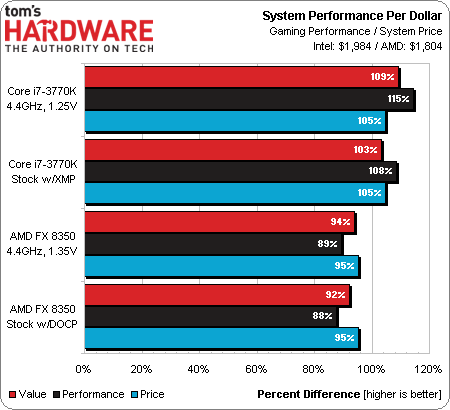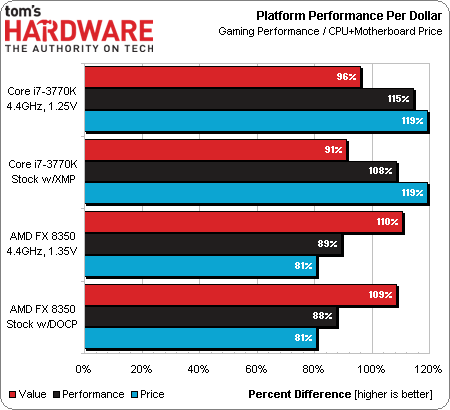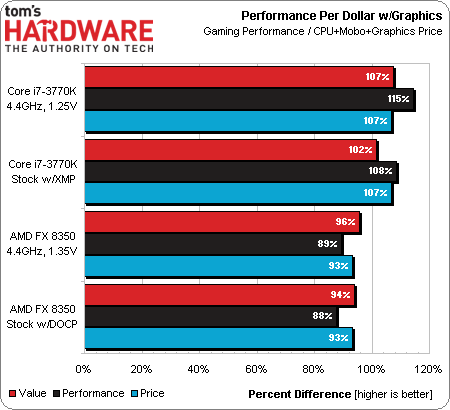FX Vs. Core i7: Exploring CPU Bottlenecks And AMD CrossFire
AMD and Intel continue serving up increasingly faster CPUs. But graphics card performance is accelerating even faster. Is there still such a thing as processor-bound gaming? We take two Radeon HD 7970s, high-end desktop CPUs, and a few games to find out.
Can AMD's FX Keep Up With Its Radeon HD 7970?
When we talk about affordable hardware that performs well, we like to use phrases like "80% the performance for 60% the price." Those are always very honest numbers, since we make it a habit to measure performance, power, and efficiency. But they only capture the value of a single component, and components cannot operate on their own.
After adding up the parts used in today's benchmark analysis, the Intel-based system crested $1,900, while the AMD platform ran us $1,724, both without cases, peripherals, or operating systems. If we wanted to call both setups "complete" solutions, we could add an $80 chassis to give us $1,984 and $1,804 machines, respectively. Since we're adding cost to both boxes, AMD's overall $180 cost savings becomes a smaller percentage of the total price tag. In other words, the other pieces that go into a nice high-end PC serve to diminish AMD's value leadership.
That leaves us with two completely biased ways to compare price to performance. We can only hope that pointing this out upfront keeps us transparent as we present the numbers.
An AMD bias would only include the price of the motherboard and CPU, maximizing value, like so:
A third alternative would allow us to talk about the motherboards and CPUs as upgrades, assuming you already have cases, power supplies, memory, and storage lying around. Of course, you probably don't have a pair of Radeon HD 7970s left over from some old machine, so the most balanced approach we can take at least takes processors, platforms, and graphics into consideration. Therefore, we're adding the $800 Tahiti-based duo to our shopping list.
The only way we can make AMD's FX-8350 look like a better gaming value than Intel's Core i7-3770K (specifically in the games and at the settings we used to test) is if the rest of the system is free. Because the rest of the system is never free, the FX-8350 never serves up better high-end gaming value.
From now on, we'll need to limit the use of AMD's flagship to systems already bottlenecked by their graphics cards. A less expensive CPU is more attractive when it isn't affecting performance negatively.
Get Tom's Hardware's best news and in-depth reviews, straight to your inbox.
Intel Bias is in the (AMD) Cards?
Our benchmark results have long shown that ATI's graphics architectures are more dependent on a strong processor than Nvidia's. As a result, we usually arm our test beds with high-end Intel CPUs when it comes time to benchmark high-end GPUs, sidestepping platform issues that might adversely affect results designed to isolate graphics performance.
We were hoping that AMD's Piledriver update would break that trend, but even a handful of impressive advancements aren't enough to match the effectiveness of AMD's graphics team. Might Steamroller be the evolutionary step forward needed to unleash the GCN architecture's peak performance?
Current page: Can AMD's FX Keep Up With Its Radeon HD 7970?
Prev Page Power And Efficiency-
A Bad Day ReplyWe were hoping that AMD's Piledriver update would break that trend, but even a handful of impressive advancements aren't enough to match the effectiveness of AMD's graphics team. Might Steamroller be the evolutionary step forward needed to unleash the GCN architecture's peak performance?
I disagree. What's needed is even stronger push on the developers to use more than four cores, effectively, not some 100% load on one core and 10% on the other five cores. -
acktionhank Great article and very informative. The FX-8350 really held it's own until it came down to Skyrim.Reply
A Bad DayI disagree. What's needed is even stronger push on the developers to use more than four cores, effectively, not some 100% load on one core and 10% on the other five cores.
I thought more cores were for multi-tasking, as in having multiple programs running simultaneously. It would suck to turn on BF3 and everything else running on my PC simply shut down because the CPU is under 100% utilization. How would i be able to play BF3 while streaming/playing some HD content on my TV that's hooked up to my same computer.
-
alidan acktionhankGreat article and very informative. The FX-8350 really held it's own until it came down to Skyrim.I thought more cores were for multi-tasking, as in having multiple programs running simultaneously. It would suck to turn on BF3 and everything else running on my PC simply shut down because the CPU is under 100% utilization. How would i be able to play BF3 while streaming/playing some HD content on my TV that's hooked up to my same computer.Reply
single core performance... look up some other benchmarks, where they use itunes to encode things, or when i believe winzip went from single core to multicore, it shows a GREAT difference more cores can do to performance.
the problem is that few games and few programs really scale, sure, pro applications almost always take advantage of whatever you put in them, but consumer, different story.
more cores can offer more multitasking, but they also allow the load to be shifted from one core to all 4 cores and get over all more performance when properly coded. -
Someone Somewhere Personally I'd like to see the i5-3570K included in here. It's closer in price to the 8350, but should perform more like the 3770K (as the games are unlikely to use more than 4 threads).Reply -
Crashman A Bad DayI disagree. What's needed is even stronger push on the developers to use more than four cores, effectively, not some 100% load on one core and 10% on the other five cores.I'm calling BS on this one because AMD's "eight cores" are actually four modules, on four front ends, with four FP units. Games have historically been limited by FP units specifically and front ends in general, no? What I'm seeing is that Intel's per-core IPC appears to be a little higher, when two different FOUR "full" CORE processors are compared.Reply -
de5_Roy like the article.Reply
woulda liked to see how a 3570k does against the fx8350 running the same cfx setup. impo, the price/perf woulda tipped further in favor of intel in configs like this.
lastly, woulda liked some newer games like sleeping dogs, far cry3, max payne 3 in the benches instead of the ol' bf3 single player. i hear bf3 sp doesn't stress cpus that much. may be bf3 skewed the benches in favor of amd as much as skyrim favored intel. :whistle: -
quark004 all these benchmarks are manipulated. First, there is this site which claims the 7900 series does well even with mid level cpus in gaming scenarios. And now toms claim a high end cpu. There is some propoganda here.Reply -
abbadon_34 It would be nice to see prices for components similar the SMB. Not because I can't look them up, but because the article is very price/performance orientedReply



